HBM technology and service for building up the first German offshore wind farm
Efficiently generating electric power without polluting the environment becomes increasingly important in times of high commodity prices and growing environmental awareness among consumers. Within the scope of the OGOWin research project for building up a first prototype of a jacket-construction-type offshore wind power plant, HBM supplies and installs test and measurement equipment for a test plant in Bremerhaven, Germany. The challenge is to install the equipment such that it also withstands the extreme stresses to which the production models will be subjected later when used in rough sea conditions.
Offshore wind farms comprise many wind turbines installed far off shore in the open sea and permanently producing clean current. This is an attractive concept which, however, is not easy to implement because of the stresses resulting from wind, waves and saltwater to which the materials used are subjected. For this reason, the German Federal Ministry for the Environment, Nature Conservation and Nuclear Safety (BMU) subsidizes the research and optimization of disarrayed foundation structures for offshore wind power plants (OGOWin) regarding material usage, the assembly process and new manufacturing methods for the carrying structure of wind power plants. Prior to the actual use of the foundation structures on the sea bed, the OGOWin project focuses on onshore research of the offshore plants.
The two main components of a wind power plant are the carrying structure (jacket + tower) and the actual nacelle with the rotor blades for generating electric power from the wind. The OGOWin project focuses on the jacket as the object of study. Researchers aim at minimizing material usage, because steel is expensive and a jacket weighs about 350 tons. In addition, the status of the wind power plant is to be continuously monitored. Maintenance cycles and the residual service life are inferred from the results.
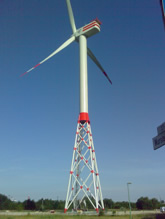
Criteria of Selecting the Measurement Technology: Positive Experiences, Convincing Results, Competent Service
The Fraunhofer Center for Wind Energy and Marine Technology (SWMT) in Bremerhaven, Germany, is responsible for the design and layout of the test and measurement equipment at the carrying structure. HBM has built up and installed the test and measurement equipment on behalf of the Fraunhofer CWMT. HBM was chosen, not least because of the positive experiences and convincing results with FINO1, a research platform for offshore wind power for which HBM provided the test and measurement equipment (electrical strain gages installed fully waterproof) already in 2003. It had been used without any problems for several years until an exceptionally strong storm destroyed parts of the platform. Moreover, HBM has a competent and international service team enabling problems to be quickly and reliably eliminated on site. And last but not least, HBM offers both technologies from a single source so that reproducibility is guaranteed.
The Measurement Chain
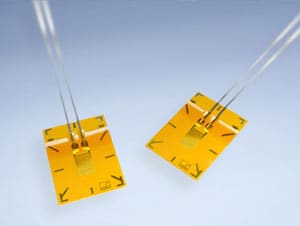
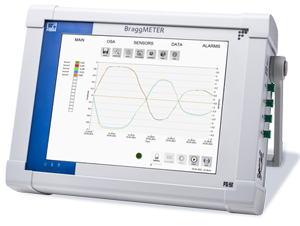
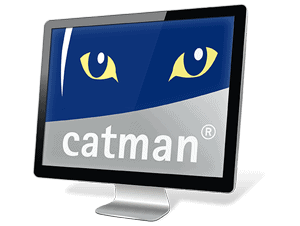
HBM's tasks in the framework of the OGOWin project include installing electrical and fiber-optical strain gages at the "stressed" points of the jacket, cabling the HBM amplifiers and transmitting the measured values to the Fraunhofer Center. The goal is to test both technologies (optical, fiber-Bragg-grating-based strain gages and electrical strain gages) with respect to reproducibility of test results and suitability for use in offshore wind power plants.
For implementing the test and measurement concept, HBM provided the required hardware and software (MGC amplifier, opto-electric interrogators, catman software) and installed about 70 strain gages on the jacket. Many measuring points were doubly configured - i.e. strain gages of both technologies were installed. The focus is on analyzing the static and dynamic behavior of the newly developed cast-iron nodes used in this design for the first time. The measuring points were covered with multiple layers to enable them to withstand many years of continuous use in a water depth of up to 40 meters. Test data is transmitted by saltwater-proof cables to the amplifier located at the foot of the tower and sent to Fraunhofer at periodic intervals. There, data is visualized, converted and analyzed using HBM's catman software.
Tecnologia e servizi HBM per la costruzione della prima centrale eolica offshore in Germania
L’efficiente generazione di energia elettrica senza inquinamento dell’ambiente assume sempre maggiore importanza in tempi di alti prezzi dei beni e di crescente consapevolezza ecologica dei consumatori.
Nell’ambito del progetto di ricerca OGOWin per la costruzione del primo prototipo di centrale elettroeolica offshore, la HBM fornisce ed installa le apparecchiatura di prova e misura.nell’impianto pilota a Bremerhaven, Germania. La sfida consiste nell’installare apparecchiature che resistano alle estreme sollecitazioni a cui i modelli di produzione saranno successivamente soggetti nelle avverse condizioni ambientali in alto mare.
Le centrali eoliche offshore consistono di molte turbine eoliche installate 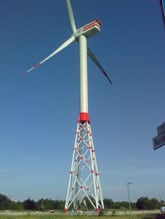
lontano in mare aperto, per produrre energia elettrica pulita. Si tratta di un concetto accattivante che, tuttavia, è di difficile realizzazione dato che i materiali impiegati sono soggetti a notevoli sollecitazioni causate dal vento, dalle onde e dall’acqua salata. Per tale ragione, il Ministero Federale Tedesco per Ambiente, Conservazione della Natura e Sicurezza Nucleare (BMU) ha finanziato la ricerca e l’ottimizzazione sulle strutture di fondazione delle centrali eoliche offshore (OGOWin) per quanto concerne l’impiego dei materiali, i processi di assemblaggio ed i nuovi metodi di costruzione delle strutture portanti delle centrali. Prima dell’impiego attuale delle strutture di fondazione sul fondo del mare, il progetto OGOWin era focalizzato nella ricerca sulle piattaforme offshore.
I due componenti principali di una centrale elettro-eolica sono la struttura portante (rivestimento e torre) e la gondola con le pale del rotore per generare l’energia elettrica dal vento. L’oggetto di studio principale del progetto OGOWin è la gondola del generatore. Lo scopo della ricerca è la riduzione del materiale impiegato, dato che l’acciaio è costoso e la gondola pesa circa 350 tonnellate. Inoltre si deve monitorare continuamente lo stato della centrale eolica. I cicli di manutenzione e la vita operativa residua vengono dedotti dai risultati del monitoraggio.
Il Centro per l’Energia Eolica e la Tecnologia Marina (SWMT) Fraunhofer in Bremerhaven, Germania, è responsabile per la progettazione e la conduzione delle apparecchiature di misura sulla struttura portante. La HMB ha realizzato ed installato l’apparecchiatura di prova e misura per conto della Fraunhofer CWMT. La HBM fu scelta anche per la positiva esperienza ed i convincenti risultati con il FINO1, una piattaforma di ricerca per centrali eoliche offshore, per cui essa fornì l’equipaggiamento di prova e misura già nel 2003, compresa l’installazione a tenuta stagna degli estensimetri elettrici. L’impianto fu usato senza alcun problema per parecchi anni finché una tempesta eccezionale distrusse parte della piattaforma. Inoltre la HBM dispone di un service competente ed internazionale, in grado di risolvere i problemi sul posto rapidamente e con affidabilità. Per ultimo, ma non meno imporante, la HBM offre sia la tecnologia elettrica che quella ottica da una sola sorgente, in modo che venga garantita la riproducibilità.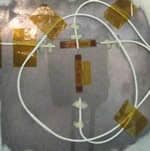
Nell’ambito del progetto OGOWin, il compito della HBM comprendeva l’installazione di estensimetri elettrici ed a fibra ottica nei punti “stressati” della gondola, nel cablaggio degli amplificatory HBM e nella trasmissione dei valori di misura al Centro Fraunhofer. Lo scopo consisteva nel provare ambedue le tecnologie (ottica, con gli estensimetri basati su filamento di Bragg,e elettrica, con gli estensimetri a resistenza tradizionali) per quanto concerne la riproducibilità dei risultati e l’idoneità all’impiego in centrali elettroeoliche offshore.
Per implementare il concetto di prova e misurazione, la HBM fornì l’hardware ed il software necessario (sistema di amplificatori MGC, interrogatori opto-elettrici, software catman®) ed installo circa 70 estensimetri sulla gondola. Molti punti di misura ebbero doppia configurazione, cioè furono installati estensimetri di entrambe le tecnologie. In particolare fu focalizzata l’analisi del comportamento statico e dinamico dei nodi di ghisa di nuova progettazione ed usati per la prima volta. I punti di misura furono ricoperti con molteplici strati di rivestimento protettivo in modo da resistere a parecchi anni di uso continuo in acqua fino alla profondità di 40 metri. Mediante cavi resistenti all’acqua di mare, i dati acquisiti venivano trasmessi agli amplificatori situati al piede della torre e trasferiti alla Fraunhofer ad intervalli di tempo prefissati. Al Centro, i dati venivano visualizzati, convertiti ed analizzati usando il software catman® della HBM.